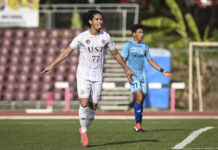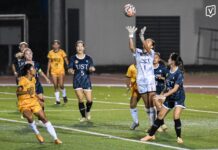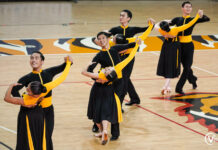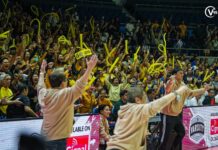 RECTOR Fr. Rolando V. de la Rosa has bared a four-year, 13-point plan to transform the country’s top private university into an influential player in national and international affairs, putting UST back on track toward its quadricentennial, a little over a year after a leadership shakeup.
RECTOR Fr. Rolando V. de la Rosa has bared a four-year, 13-point plan to transform the country’s top private university into an influential player in national and international affairs, putting UST back on track toward its quadricentennial, a little over a year after a leadership shakeup.
Delivering his first Rector’s Report since returning to his old post in September 2007, De la Rosa also unveiled a fresh vision and mission statement and told administrators and faculty members last November 7 that UST remains ahead in many respects, but must strive to be more relevant to society.
De la Rosa announced a nearly half-a-billion-peso operating surplus for academic year 2007-2008, but called on all Thomasians to help control costs as the excess collections were not enough to cover capital expenditures, loan repayments, and a deficit in the previous year — leading to an outstanding balance of P233 million.
It was actually De la Rosa’s ninth Rector’s Report, having served as UST rector from 1991 to 1998, a tumultous time for the University which many remember as a “golden age.”
The Rector’s 13-point agenda seeks a return to prominence, and states that by 2012, UST must have taken measures “towards becoming a globally recognized institution of higher learning compliant with international standards in the fields of instruction and research.”
UST also wants a larger influence in media, as well as in policy formulation and in the “renewal of the Church in the Philippines and in the Asia Pacific region.”
The updated vision and mission statement calls for “actualizing the professional and moral formation of (UST) students and effecting social transformation,” with ideals “rooted on the mission of evangelization.”
Programs, faculty
De la Rosa said most of UST’s programs should attain Level 3 accreditation in four years, as well as the coveted Center of Excellence bestowed by the Commission on Higher Education.
Nine programs now enjoy Center of Excellence status: Architecture, Chemistry, Secondary and Elementary Education, Philosophy, Literature, Music, Nursing, Medicine, and Electronics and Communication Engineering.
The Biology program has been named Center for Development, while the College of Education has been conferred the Center for Training status.
Also, 10 programs have reached a Level 3 status, most of which are in the College of Science: Biology, Microbiology, Chemistry, Mathematics, and Psychology, as well as Pharmacy, Economics, Legal Management, Literature, and Philosophy.
De la Rosa pointed out that UST has consistently topped all private universities when it comes to passing rates in board exams, and many students and professors continue to reap awards.
Citing the recent approval of a new collective bargaining agreement (CBA) with the faculty and support staff, De la Rosa noted that “industrial peace” has prevailed in UST for a long time but said promotions must continue to be based on merit.
“I dread the day when faculty promotions are just automatic, based solely on the points required by the CBA, without due consideration given to the faculty member’s willingness or desire to improve himself or herself as an individual and as a professional,” he said.
The Rector said UST has not been remiss when it comes to supporting faculty development—funding for sabbatical leaves and study grants reached P5.6 million last year while scholarship grants totalled P1.5 million.
The 95th Rector also mentioned international linkages with universities from Brazil, Australia, Germany, Japan, Hongkong, Indonesia, and the U.S.
Also, UST continued to dominate collegiate sports, again winning the General Championship of the Universities Athletics Association of the Philippines (UAAP), with some Thomasian athletes competing in major events such as the Southeast Asian Games.
Library and publishing
UST continued to upgrade facilities, spending P30 million last year for 5,482 titles and subscriptions alone.
The Publishing House continues to produce academic titles despite losses of up to P30 million, the Rector said, but the rewards were worth it: out of the 38 titles published last year, 13 were shortlisted for the Manila Critics Circle’s National Book Awards.
The Office of Research and Development had reported a total of 125 research papers for last year, De la Rosa said. Out of these, 35 were published in international journals and 46 in national publications.
The research budget reached P60 million last year. Under the 13-point plan, UST must be an “active collaborator with industry, government, international organizations, other local and international institutions of higher learning and the Church in the field of research.”
Given this priority for research, De la Rosa urged Thomasian researchers to do more than “discovering knowledge.”
“We must do a collaborative endeavor with other research outfits. The fruits of research must not only discover new knowledge. Let us not be contented with published works; we must apply them,” he said, adding that “very few (works) are patented.”
As part of the research goals, he announced the transfer of the UST Graduate School to the Thomas Aquinas Research Complex to incorporate research into graduate studies.
Cost-cutting
De la Rosa said UST continues to attract many students, with close to 40,000 taking the yearly entrance exams.
With the administration deciding to increase the student population to 40,000, tuition served as the “main driver” of the P466 million operating surplus last year.
But instead of resorting to tuition increase, cost-cutting procedures like bringing down electricity consumption should be the norm, he said.
‘These Three’
In a speech before the Rector’s Report, Vice Rector Fr. Pablo Tiong, O.P. underscored UST’s long-lasting stability.
“Rectors and vice-rectors come and go but the stability we pray for UST will continue. UST is gifted with stability but will happen only so with God because he is the giver of it,” Tiong said.
Tiong and De la Rosa said UST will have the gift of stability so long as it follows the “Tria Haec” of love, faith, and hope—represented by the towering figures atop the Main Building.
De la Rosa was again in his usual humorous style, delivering an unconventional Rector’s Report complete with a lengthy PowerPoint presentation.
His report was punctuated by production numbers from students, faculty, support staff, and administrators to keep the audience alert, prompting the Rector to remark that his report in fact served as intermission to the song-and-dance numbers.
De la Rosa ended his report recalling how UST’s sports mascot, the Growling Tigers, came to being.
He recalled that when he first assumed the rectorship in 1991, UST was known as the “Glowing Goldies,” sporting the papal colors of yellow and white.
But unlike other schools, UST really had no mascot to speak of, and so he said he was embarrased when a “fat Dominican” carrying bags of gold came out to represent UST in the 1991 UAAP opening ceremony hosted by another school.
After that, De la Rosa instructed the then P.E. moderator, Bro. Rolando Atienza, O.P., to search for an appropriate mascot, and so UST came to be known as the home of the Growling Tigers.
De la Rosa said that unlike the “Goldies,” which had no concrete representation of UST, the “Tigers” made an impact and gave the University a solid mark.
“Tigers are known for their intelligence and low-key status. But provoked, they become aggressive. We’ve been identified with the Tigers. We no longer bask in anonymity,” he said.
Like the transition from the Goldies to the Tigers, the Thomasian community should “focus on transition, not change.”
“Transition is internal. It is the psychological process that puts the mind in terms with the needed changes. The starting point of every transition is not the envisioned outcome, but the decision to change. We are still in a transition that is ongoing,” he said.
MID-TERM GOALS
(2008-2012)
By 2012, UST will:
- Have taken measures towards becoming a globally recognized institution of higher learning in accordance with international standards in instruction and research.
- Have widened and intensified its influence in the media, in policy formulation in society and in the renewal of the Church in the Philippines and in the Asia Pacific.
- Have become an active collaborator with industry, government, international organizations, other local and international institutions of higher learning and the Church in the field of research.
- Have become a partner of the Church and government in improving the quality of life of the Filipino people.
- Have developed and patented research outputs that promote physical, intellectual, social, emotional and spiritual well-being.
- Have accomplished Level 3 accreditation and Center of Excellence status for most of its programs.
- Have achieved a significant presence in General Santos City in North Cotabato, Sta. Rosa in Laguna, and in Marikina.
- Have been declared a National Heritage Site by local and international cultural agencies.
- Have established the appropriate organizational structure and operational systems and procedures to attain optimum efficiency and effectiveness in the delivery of services to its stakeholders.
- Have maximized the use of its resources.
- Have ladderized and vertically articulated its curricular offerings (where applicable).
- Have established a strong and mutually enriching partnership with the alumni to help realize the University’s medium- and long-term goals.
- Have intensified the moral and spiritual development of the entire Thomasian community through a unified and responsive chaplaincy structure.

















